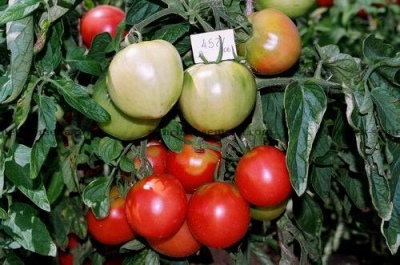
- Authors: Panchev Yu.I.
- Year of approval: 2010
- Category: hybrid
- Growth type: determinant
- Appointment: fresh consumption
- Ripening period: ultra early
- Ripening time, days: 82-85
- Growing conditions: for open ground, for film greenhouses
- Transportability: Yes
- Marketable fruit yield,%: 98%
Tomatoes with a fruit color other than red are very popular. However, they must be used carefully and thoughtfully. Only with careful study can the Pink Miracle bring good harvests.
Description of the variety
The tomato created by Yu. I. Panchev and officially registered in 2010 demonstrates the traditional determinant logic of development. You can meet the planting of such a plant both in open ground and in greenhouses under a film. Compact bushes grow up to 1-1.1 m. There are not so many leaves, but they are large and have a light green color.
The main qualities of the fruit
Pink Miracle Berries:
have a marketable appearance in 98% of cases (subject to the requirements for caring for them);
are initially light green and have a green spot;
in a mature state, they acquire a crimson color;
weigh on average 100 g and have a rounded shape;
formed from inflorescences of a simple type;
covered with a smooth skin;
have a good keeping quality.
Taste characteristics
The fruits of the Pink Miracle are sweet. Their pulp is of medium density.
Ripening and fruiting
The pink miracle is one of the representatives of ultra-early tomatoes. Under normal conditions for himself, he forms a harvest in 82-85 days. However, sometimes this period is violated if the weather conditions change, or the measures for caring for the landings differ.
Yield
The declared ability to produce 2.3 kg of berries per 1 sq. m. This is not too outstanding, but the result is consistently achieved. Properly selected agricultural technology plays an important role.
The timing of planting seedlings and planting in the ground
It is necessary to sow seeds in containers in March or April. The specific period should be chosen by the gardeners themselves. Seedless cultivation of this variety is almost impossible. Plants are usually transplanted from containers to a permanent place at the age of 60 days. But it is imperative to assess how fully they will have time to develop.

Growing tomato seedlings is an extremely important process, because it largely depends on whether the gardener can harvest at all. All aspects must be taken into account, from seedbed preparation to planting in the ground.
Landing scheme
For 1 "square" of the garden there should be 3 or 4 bushes of the Pink Miracle. If you plant a little less, leaving is greatly simplified. In the official description, the order of distribution of holes is not regulated. Third-party sources write that they should be placed on a 700x400 mm system.

Growing and caring
Keep containers or regular seedling boxes warm. The depth of introduction of grains into the substrate is no more than 10-15 mm. A comfortable (from 23 to 25 degrees) temperature is necessarily maintained. In some cases, plantings have to be illuminated. Watering the seedlings should be moderate, and with stable development, they will not need feeding.
If the seedlings are too weak, they must be fed with sodium humate. The pick is performed when the second true sheet appears. On the 15th day after the pick, use a nitrophoska (although some farmers prefer nitroammophoska). Acclimatization (aka hardening) is carried out 7-14 days before disembarkation. For this, places inaccessible to wind and sunlight are chosen.
The picking of the Pink Miracle should be performed immediately into separate tanks. This will conserve the strength of the bush and increase the chances of rooting in the ground. The removal of stepchildren is very important due to the intense growth of the fruit mass. For the same reason, it is recommended to use stakes or small trellises. Other recommendations:
in a soil saturated with useful substances, lead a tomato in 2-3 stalks;
water the crop in moderation and increase watering when the berries are poured;
during the growing season, 2 organic fertilizing should be carried out.




A plant needs different micronutrients at each stage of growth. All fertilizers can be divided into two groups: mineral and organic. Folk remedies are often used: iodine, yeast, bird droppings, eggshells.
It is important to observe the rate and period of feeding. This also applies to folk remedies and organic fertilizers.


Growing regions
Tomatoes Pink Miracle can be cultivated in:
Siberian regions;
regions of the Far East;
Central Black Earth Region;
Volgo-Vyatka region;
Volga region;
northern, northwestern and central regions of the European part of Russia;
territories and republics of the North Caucasus.
Review overview
The taste qualities of this variety are liked by the overwhelming majority of farmers. At the same time, there is a very high sensitivity to cold. The likelihood of illness is low. Some farmers are disappointed. At the same time, no one denies the speed of ripening and its friendly nature.

























































































